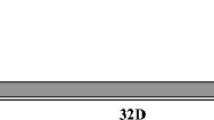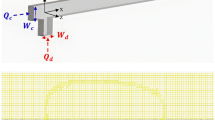Abstract
Immiscible kerosene-water two-phase flows in microchannels connected by a T-junction were numerically studied by a Lattice Boltzmann (LB) method based on field mediators. The two-phase flow lattice Boltzmann model was first validated and improved by several test cases of a still droplet. The five distinct flow regimes of the kerosene-water system, previously identified in the experiments from Zhao et al., were reproduced. The quantitative and qualitative agreement between the simulations and the experimental data show the effectiveness of the numerical method. The roles of the interfacial tension and contact angle on the flow patterns and shapes of droplets were discussed and highlighted according to the numerical results based on the improved two-phase LB model. This work demonstrated that the developed LBM simulator is a viable tool to study immiscible two-phase flows in microchannels, and such a tool could provide tangible guidance for the design of various microfluidic devices that involve immiscible multi-phase flows.
Similar content being viewed by others
References
Cristini V, Tan YC. Theory and numerical simulation of droplet dynamics in complex flows—a review. Lab Chip, 2004, 4: 257–264
Gunther A, Jensen KF. Multiphase microfluidics: from flow characteristics to chemical and materials synthesis. Lab Chip, 2006, 6: 1487–503
Lomel S, Falk L, Commenge JM, Houzelot JL, Ramdani K. The microreactor: A systematic and efficient tool for the transition from batch to continuous process. Chem Eng Res Des, 2006, 84(A5): 1–7
Kiwi-Minsker L, Renken A. Micro-structured reactors for catalytic reactions. Catal Today, 2005, 110: 2–14
Christopher GF, Anna SL. Microfluidic methods for generating continuous droplet streams. J Phys D Appl Phys, 2007, 40: R319–R336
Nisisako T, Torii T, Higuchi T. Droplet formation in a microchannel network. Lab Chip, 2002, 2: 24–26
Wang K, Lu YC, Xu JH, Luo GS. Determination of dynamic interfacial tension and its effect on droplet formation in the T-shaped microdispersion process. Langmuir, 2009, 25: 2153–2158
Dessimoz AL, Cavin L, Renken A, Kiwi-Minsker L. Liquid-liquid two-phase flow patterns and mass transfer characteristics in rectangular glass micro-reactors. Chem Eng Sci, 2008, 63: 4035–4044
Triplett KA, Ghiaasiaan SM, Abdel-Khalik SI, Sadowski DL. Gas-liquid two-phase flow in microchannels, Part I: two-phase flow pattern. Int J Multiphase Flow, 1999, 25: 377–394
Xu JL, Cheng P, Zhao TS. Gas-liquid two-phase flow regimes in rectangular channels with mini/microgaps. Int J Multiphase Flow, 1999, 25: 411–432
Yu Z, Hemminger O, Fan LS. Experiment and lattice Boltzmann simulation of two-phase gas-liquid flows in microchannels. Chem Eng Sci, 2007, 62: 7172–7183
Takamasa T, Hazuku T, Hibiki T. Experimental study of gas-liquid two-phase flow affected by wall surface wettability. Int J Heat Fluid Flow, 2008, 29: 1593–1602
Donata MF, Franz T, Philipp RVR. Segmented gas-liquid flow characterization in rectangular microchannels. Int J Multiphase Flow, 2008, 34: 1108–1118
Pandey S, Gupta A, Chakrabarti DP, Das G, Ray S. Liquid-liquid two phase flow through a horizontal T-junction. Chem Eng Res Des, 2006, 84: 895–904
Kashid MN, Agar DW. Hydrodynamics of liquid-liquid slug flow capillary micro-reactor: flow regimes, slug size and pressure drop. Chem Eng J, 2007, 131: 1–13
Xu JH, Luo GS, Li SW, Chen GG. Shear force induced monodisperse droplet formation in a microfluidic device by controlling wetting properties. Lab Chip, 2006, 6:131–136
Zhao YC, Chen GW, Yuan Q. Liquid-liquid two-phase flow patterns in a rectangular microchannel. AIChE J, 2006, 52: 4052–4060
Zhao YC, Ying Y, Chen GW, Yuan Q. Characterization of micromixing in T-shaped micromixer (in Chinese). J Chem Ind Eng, 2006, 57: 1184–1190
Zhao YC, Chen GW, Yuan Q. Liquid-liquid two-phase mass transfer in the T-junction microchannels. AIChE J, 2007, 53: 3042–3053
Kobayashi I, Mukataka S, Nakajima M. Production of monodisperse oil-in-water emulsions using a large silicon straight through microchannel plate. Ind Eng Chem Res, 2005, 44: 5852–5856
Zheng B, Tice JD, Ismagilov RF. Formation of droplets of alternating composition in microfluidic channels and applications to indexing of concentrations in droplet-based assays. Anal Chem, 2004, 76: 4977–4982
Thorsen T, Roberts RW, Arnold FH, Quake SR. Dynamic pattern formation in a vesicle-generating microfluidic device. Phys Rev Lett, 2001, 86: 4163–4166
Dreyfus R, Tabeling P, Willaime H. Ordered and disordered patterns in two-phase flows in microchannels. Phys Rev Lett, 2003, 90: 144505
Tan J, Xu JH, Li SW, Luo GS. Drop dispenser in a cross-junction microfluidic device: Scaling and mechanism of break-up. Chem Eng J, 2008, 136: 306–311
Gong XC, Lu YC, Xiang ZY, Zhang YN, Luo GS. Preparation of uniform microcapsules with silicone oil as continuous phase in a microdispersion process. J Microencapsul, 2007, 24: 767–776
Liow JL. Numerical simulation of drop formation in a T-shaped microchannel. 15th Australasian Fluid Mechanics Conference, Sydney, Australia, 2004
Shui LL, Eijkel JCT, van den Berg A. Multiphase flow in microfluidic systems—Control and applications of droplets and interfaces. Adv Colloid Interface Sci, 2007, 133: 35–49
Shui LL, Eijkel JCT, van den Berg A. Multiphase flow in micro- and nano-channels. Sensors Actuators B, 2007, 121: 263–276
Gunstensen AK, Rothman DH, Zaleski S, Zanetti G. Lattice Boltzmann model of immiscible fluids. Phys Rev A, 1991, 43: 4320–4327
Gunstensen AK, Rothman DH. A lattice-gas model for three immiscible fluids. Phys D: Nonlinear Phenomena, 1991, 47: 47–52
Gunstensen AK, Rothman DH. A Galilean-invariant immiscible lattice gas. Phys D: Nonlinear Phenomena, 1991, 47: 53–63
Shan X, Chen H. Lattice Boltzmann model for simulating flows with multiple phases and components. Phys Rev E, 1993, 47: 1815–1819
Swift MR, Osborn WR, Yeomans JM. Lattice Boltzmann simulation of nonideal fluids. Phys Rev Lett, 1995, 75: 830–833
Junseok K. A diffuse-interface model for axisymmetric immiscible two-phase flow. Appl Math Comput, 2005, 160: 589–606
Sankaranarayanan K, Kevrekidis IG, Sundaresan S, Lu J, Tryggvason GA. Comparative study of lattice Boltzmann and front-tracking finite-difference methods for bubble simulations. Int J Multiphase Flow, 2003, 29: 109–116
Sankaranarayanan K, Shan X, Kevrekidis IG, Sundaresan S. Analysis of drag and virtual mass forces in bubbly suspensions using an implicit formulation of the lattice Boltzmann method. J Fluid Mech, 2002, 452: 61–96
Santos LOE, Facin PC, Philippi PC. Lattice-Boltzmann model based on field mediators for immiscible fluids. Phys Rev E, 2003, 68: 056302
Santos LOE, Wolf FG, Philippi PC. Dynamics of interface displace ment in capillary flow. J Stat Phys, 2005, 121: 197–207
Surmas R, dos Santos LOE, Philippi PC. Lattice Boltzmann simulation of the flow interference in bluff body wakes. Future Gener Comp Sys, 2004, 20: 951–958
Facin PC, Philippi PC, dos Santos LOE. A non-linear lattice-Boltzmann model for ideal miscible fluids. Future Gener Comp Sys, 2004, 20: 945–949
Philippi PC, Hegele LA, dos Santos LOE, Rodrigo S. From the continuous to the lattice Boltzmann equation: The discretization problem and thermal models. Phys Rev E, 2006, 73: 056702
Surmas R, Pico CE, dos Santos LOE, Philippi PC. Volume exclusion for reducing compressibility effects in lattice Boltzmann models. Int J Mod Phys, 2007, 18: 576–584
Pico CE, dos Santos LOE, Philippi PC. A two-fluid BGK lattice Boltzmann model for ideal mixtures. Int J Mod Phys, 2007, 18: 566–575
Philippi PC, Hegele LA, Surmas R, Siebert DN, dos Santos LOE. From the Boltzmann to the lattice-Boltzmann equation: Beyond BGK collision models. Int J Mod Phys, 2007, 18: 556–565
Siebert DN, Hegele LA, Surmas R, dos Santos LOE, Philippi PC. Thermal lattice Boltzmann in two dimensions. Int J Mod Phys, 2007, 18: 546–555
Wolf FG, dos Santos LOE, Philippi PC. Micro-hydrodynamics of immiscible displacement inside two-dimensional porous media. Microfluidics Nanofluidics, 2008, 4: 307–319
Wolf FG, dos Santos LOE, Philippi PC. Modeling and simulation of the fluid-solid interaction in wetting. J Stat Mech-Theory Exp, 2009, P06008
Guillot P, Colin A. Stability of parallel flows in a microchannel after a T junction. Phys Rev E, 2005, 72: 066301.
Squires TM, Quake SR. Microfluidics: fluid physics at the nanoliter scale. Rev Mod Phys, 2005, 77: 977–1026
Hudson SD, Goodrum WJ, Kathryn J, Beers L, Amis EJ. Microfluidic interfacial tensiometry. Appl Phys Lett, 2005, 87: 081905
Cabral JT, Hudson SD. Microfluidic approach for rapid multicomponent interfacial tensiometry. Lab Chip, 2006, 6: 427–436
Fang C, Hidrovo C, Wang FM, Eaton J, Goodson K. 3-D numerical simulation of contact angle hysteresis for microscale two phase flow. Int J Multiphase Flow, 2008, 34: 690–705
Shan XW. Analysis and reduction of the spurious current in a class of multiphase lattice Boltzmann models. Phys Rev E, 2006, 73: 047701
Fakhari A, Rahimian MH. Simulation of falling droplet by the lattice Boltzmann method. Commun Nonlinear Sci Numer Simulat, 2009, 14: 3046–3055
Maruyama T, Matsushita H, Uchida JI, Kubota F, Kamiya N, Goto M. Liquid membrane operations in a microfluidic device for selective separation of metal ions. Anal Chem, 2004, 76: 4495–4500
Dong HF, Zhang DL, Zhao YC, Chen GW, Yuan Q. Numerical simulation of immiscible two-phase flow in T-shaped microchannel (in Chinese). J Chem Ind Eng, 2008, 59: 1950–1957
Qian DY, Lawal A. Numerical study on gas and liquid slugs for Taylor flow in a T-junction microchannel. Chem Eng Sci, 2006, 61: 7609–7625
Kreutzer MT, Kapteijin F, Moulijn JA, Heiszwolf JJ. Multiphase monolith reactors: Chemical reaction engineering of segmented flow in microchannels. Chem Eng Sci, 2005, 60: 5895–5916
Taha T, Cui ZF. CFD modelling of slug flow in vertical tubes. Chem Eng Sci, 2006, 61: 676–687
van Baten JM, Krishna R. CFD simulations of wall mass transfer for Taylor flow in circular capillaries. Chem Eng Sci, 2005, 60: 1117–1126
Author information
Authors and Affiliations
Corresponding author
Rights and permissions
About this article
Cite this article
Yong, Y., Yang, C., Jiang, Y. et al. Numerical simulation of immiscible liquid-liquid flow in microchannels using lattice Boltzmann method. Sci. China Chem. 54, 244–256 (2011). https://doi.org/10.1007/s11426-010-4164-z
Received:
Accepted:
Published:
Issue Date:
DOI: https://doi.org/10.1007/s11426-010-4164-z




